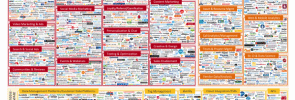The world of marketing technology solutions keeps growing and growing, and keeping on top of it can be challenging for marketing professionals. Case in point: chiefmartec.com’s annual marketing technology supergraphic for 2015 is twice the size of last year’s informal roundup of tech suppliers, with 1,876 vendors represented across 43 categories. Chief Marketer sat down with Scott Brinker, co-founder and CTO of ion interactive and the creator of the Chief Marketing Technologist Blog, to get a clearer picture of the marketing tech landscape and what’s on the horizon.
CHIEF MARKETER: How has the marketing tech landscape evolved over the past year?
SCOTT BRINKER: First, the fact that the number of companies on the list has doubled over last year is definitely not because that many new companies have been created over the past 12 months. It’s actually that it’s really hard to find all of these companies. It turns out that I really did miss hundreds of companies—there are different ecosystems internationally in Europe and Asia. We live in a world where we come to expect that we can Google things and just get our answers, but the research on this has taught me that we’re a long ways away from that with marketing tech. All of these different companies have found different niches, whether it’s a market segment or geography or a particular functional specialization. There are more and more companies out there, like G2 Crowd and TrustRadius, that are services that have been built to help marketers find and evaluate different software. Both of those were incredibly helpful tools in discovering some of these companies.
months. It’s actually that it’s really hard to find all of these companies. It turns out that I really did miss hundreds of companies—there are different ecosystems internationally in Europe and Asia. We live in a world where we come to expect that we can Google things and just get our answers, but the research on this has taught me that we’re a long ways away from that with marketing tech. All of these different companies have found different niches, whether it’s a market segment or geography or a particular functional specialization. There are more and more companies out there, like G2 Crowd and TrustRadius, that are services that have been built to help marketers find and evaluate different software. Both of those were incredibly helpful tools in discovering some of these companies.
As far as the landscape, I think the notion of consolidation around the major marketing clouds is happening, but is certainly continuing to be paired with ongoing innovation across the board. If you look at Adobe, Oracle, Salesforce, Marketo, all of those companies in the past year have made a lot of investment in developing ISV ecosystems and altering their value proposition to not just be one suite that does it all, but a foundational system that is also an open platform to support other plug-in technologies. That’s a pretty big shift from where this industry was a year ago.
Another thing that’s notable is the growth of middleware categories, such as customer data platforms and tag management systems. The reason why they’re thriving is because whether it’s through data or cloud API management, they’re making it easier for marketers to connect all of these different pieces and pull out shared data insights.
CM: How can marketers sort though the marketing tech landscape to find the solutions that will work best for their companies?
SB: As soon as you get to a place where you know what you want and what capabilities you want to have in your marketing and customer experience, there’s a set of criteria that should fairly quickly narrow the field. You still might have a couple of dozen vendors that you may want to seriously look at, which is admittedly a lot, but it’s not like you have to look at all 2,000 in a serious way. A lot of these solutions are very different, and solutions people are using to manage display ad campaigns are different than tools for content management or website production. There is a larger net in which you want to slowly connect the data you get to the same common place, but many are different tools for different needs.
CM: How have marketing cloud platform solutions evolved in the past year?
SB: The key here is the shift that most of the major players have taken to become open platforms that have ISV ecosystems, not just all-in-one solutions. It dramatically reduces the amount of integration that a marketer has to do. It’s helping to make this highly varied landscape more manageable for marketers. When marketers are looking at whatever foundational system is going to be the backbone of their marketing technology infrastructure, they really do want to make a choice that’s committed to that kind of open architecture and ISV ecosystem because it gives you all of the flexibility to pick new innovations as they become available.
CM: How are middleware solutions making marketers’ lives easier?
SB: The number of vendors in that space has grown significantly in the past year, but also I think their popularity has grown dramatically. If you look at things like tag management systems, when they were first created they had a relatively simple task—to help manage placing different scripts on a website in a more structured way. Now they’ve advanced way beyond that, because all of those tags placed on web touch points actually become conduits of data, so they’ve gotten really good at being able to collect and manage that data layer on top of those tags. It boils down to letting marketers take very different kinds of products and collect that data into a common repository and get more of a unified view of it.



